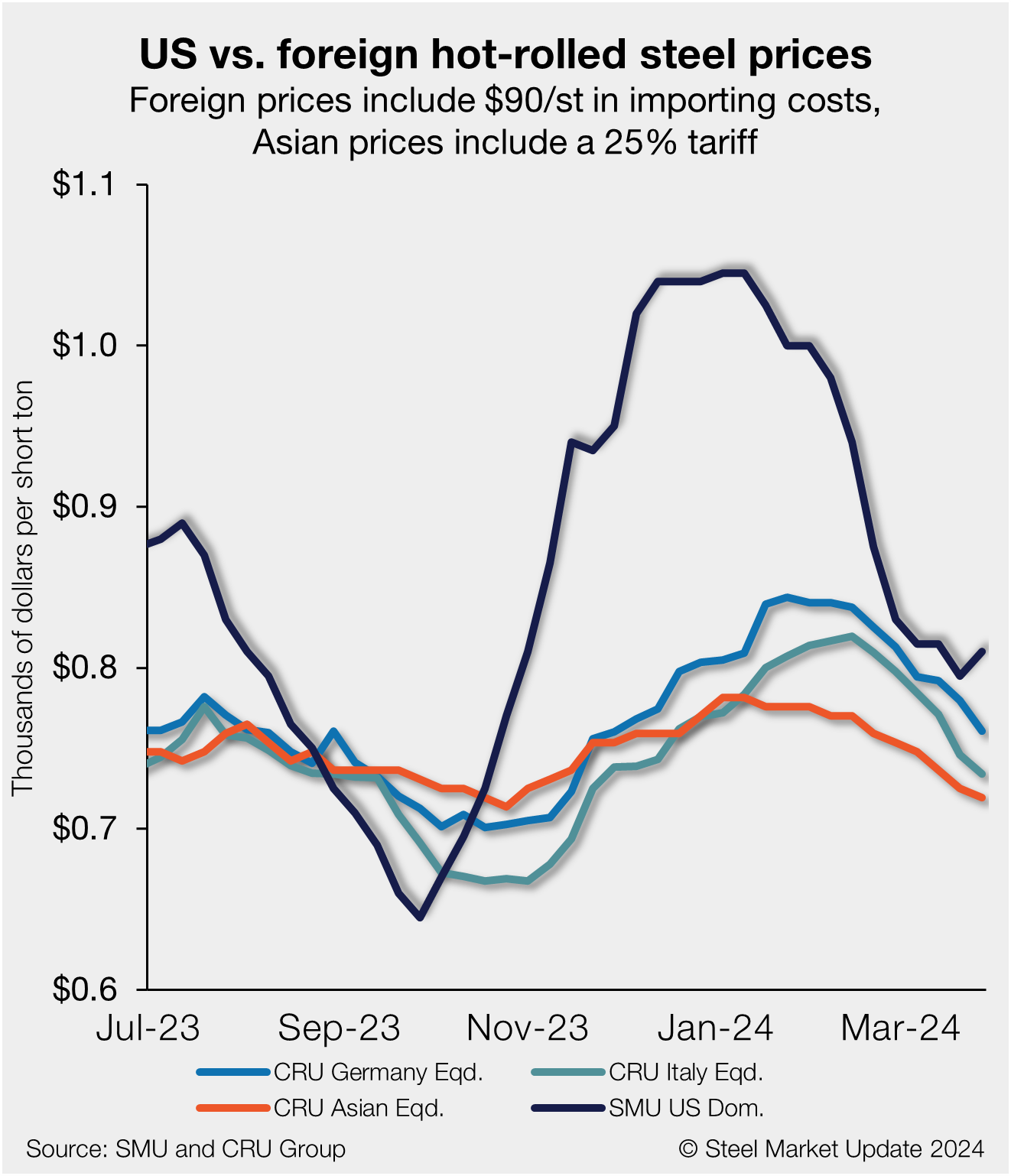Steel Products Prices North America

Is Trump Administration the Next Black Swan Event?
Written by John Packard
April 27, 2017
Is the newly initiated Section 232 the Black Swan event that will remove steel supply from the market and tip the balance of supply/demand in favor of the domestic steel mills, thus pushing prices to levels not seen since 2008? There should not be any doubt that the make-up of the Trump Administration, coupled with the legal abilities assigned to the Executive Branch as it relates to trade, means change is coming and it will impact the steel and manufacturing industries.
Steel Market Update does not know exactly what items or what countries will be impacted by the Section 232 investigation as well as any other actions that can be taken by the Administration (Section 201, circumvention ruling, Section 337, future antidumping and countervailing duties which can be “self-initiated” by the US Department of Commerce).
It is our opinion that the Trump Administration could very well conduct “shock and awe” rulings regarding imported steel. They have proven they are not worried about potential downstream costs when earlier this week they ruled against Canadian soft wood companies who now must pay duties up to 24 percent. Canadian companies ship $5.6 billion worth of wood and wood products to the United States on a yearly basis. You would think we would treat Canada a little better than we would Vietnam or Brazil.
Cowen & Company and their research group Cowen Washington Research Group put out an interesting analysis on the ability of the Trump Administration to affect the steel industry. Buyers and sellers of steel need to appreciate the ability of the Trump Administration to impact the industry and to become, in effect, the next Black Swan Event, which will drive steel prices by controlling foreign steel supply.
Chris Kruger of the Cowen Washington Research Group reported to their clients, “We have flagged Trump’s near unilateral powers on trade as one of the greatest short-term policy risks since his election in November. The U.S. has not had a protectionist/defensive trade President since The Great Depression. Renegotiating deals/tariffs one of the few bipartisan issues of campaign. Ironically, Trump has TPA/fast-track negotiating power for four years thanks to Obama and GOP Congress. In 2015, the Congress passed a new Trade Promotion Authority measure that grants the President “fast track” trade negotiating power that will extend to 2020. This essentially means any new trade deals can not be amended by the Congress and are not able to be filibustered, and must receive an up-or-down vote. So President Trump has broad discretion and power to cut new deals – along with scrapping old deals.”
Kruger pointed out that “Trump’s zero-sum view on trade” is shared by Commerce Secretary Wilbur Ross. We cannot forget that there are many other steel related individuals involved in the Trump Administration in trade capacities such as attorney Robert Lighthizer as U.S. Trade Representative. Lighthizer’s largest client was U.S. Steel. The U.S. Senate Finance Committee unanimously approved Lighthizer nomination on Tuesday of this week.
The article also point outs, “Per the Constitution, the Congress has the power/authority to regulate international trade (trade deals – basically, the beneficial aspects) but the 1974 Trade Act gives the President much more authority and large sway over tariffs. Two other bills that give the Commander in Chief broad authority over trade policy: Trading With Enemy Act of 1917 and International Emergency Economic Powers Act of 1973. Invoking either the 1917 or 1973 laws would be (as far as we can tell) unprecedented, though President Trump and precedence are not frequently in the same sentence. Trump’s nationalism/mercantilism trade policy enjoys a broad coalition of political support, which continues to give him wide latitude as he gores every sacred cow and hugs every third rail in politics.”
![]() SMU Opinion:
SMU Opinion:
SMU opinion is buyers of flat rolled steel need to tread carefully until we start getting answers to the questions of what is going to happen to steel imports, what products will be impacted and what does that mean for traders, manufacturers and those distributing foreign steel.
Foreign steel imports are all about risk going forward. Price could become a bigger issue as buyers may require even larger spreads between foreign and domestic pricing in order to take the risks necessary to order steel that has a 3 to 6-month lead time before receipt. We expect trading companies to begin offering steel with a provision that removes their risk to perform should special tariffs or restrictions be placed on the material in question.
We warn our readers to be vigilant and stay engaged with your suppliers (foreign and domestic). We do not know if the Trump Administration will block hot rolled, cold rolled, galvanized, Galvalume, plate or pipe and tube products. We do feel that this is something that should be taken seriously by all involved.
It is also our opinion that manufacturing companies and others either helped or hurt by any Section 232 ruling for or against your steel product need to participate in the process. The Section 232 investigation is taking comments from the public in both a hearing as well as in writing. Here is more information which comes from the Federal Register dated April 26, 2017:
Written comments: Send written comments to Brad Botwin, Director, Industrial Studies, Office of Technology Evaluation, Bureau of Industry and Security, U.S. Department of Commerce, 1401 Constitution Avenue NW., Room 1093, Washington, DC 20230 or by email to Steel232@bis.doc.gov.
Public hearing [May 24, 2017]: Send requests to speak and written summaries of the oral presentations to Brad Botwin, Director, Industrial Studies, Office of Technology Evaluation, Bureau of Industry and Security, U.S. Department of Commerce, Room 1093, 1401 Constitution Avenue NW., Washington, DC 20230 or by email to Steel232@bis.doc.gov, by May 17, 2017. Any person, whether presenting or not, may submit a written statement through May 31, 2017—7 days after the hearing date.

John Packard
Read more from John PackardLatest in Steel Products Prices North America

SMU price ranges: Sheet, plate largely unchanged
Sheet prices varied this week. While hot-rolled (HR) coil pricing was largely flat, cold-rolled (CR) coil and tandem product pricing eased slightly reflecting the momentum shift seen last week for HR coil. SMU’s average HR coil price was flat from last week at $835 per short ton (st) – potentially emphasizing the tension between competing […]

Nucor posts $830/ton spot HR price for week of April 8
Nucor said its spot hot-rolled (HR) coil price this week will be $830 per short ton (st).

US HR prices rebound, no longer near parity with imports
US hot-rolled coil and offshore hot band moved further away from parity this week as stateside prices have begun to move higher in response to mill increases.

Galvanized buyers report solid demand, balanced inventories
Galvanized buyers reported solid demand and balanced inventories this week and were anticipating the sheet price increase announced by Cleveland-Cliffs on Wednesday.
HRC vs. CRC price spread jumps in second week of new year
The spread between cold-rolled coil (CRC) and hot-rolled coil (HRC) prices jumped during the week of Jan. 8 as cold rolled tags continued to rise while hot rolled tags held steady.
